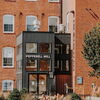Developer hopes to 'switch' historic telephone building in Portland to become apartments
 Photo / William Hall
The proposed conversion of 45 Forest Ave. in Portland would create 81 apartments.
Photo / William Hall
The proposed conversion of 45 Forest Ave. in Portland would create 81 apartments.
The historic, mostly vacant New England Telephone & Telegraph Co. building in Portland may be converted into 81 small apartments, extending a trend seen nationally of turning office space into residential properties.
If the Portland Planning Board approves a change in use over the coming weeks, the redo of 45 Forest Ave. will add much-needed inventory to the city's scarce housing stock. The addition would include 20 units deemed affordable in compliance with zoning requirements approved by voters last year.
Built in 1912, the six-story brick building originally housed a switching center and offices for NET&T, and was owned by telecom Consolidated Communications until developer Redfern Properties purchased it.
Redfern aims to create 30 one-bedroom apartments and 51 studio apartments. The building will also have a fitness room and lounge, according to a plan submitted to the Planning Board. The project's price tag is $18 million to $20 million.
The apartments are in the range of about 350 square feet to about 600 square feet.
“We’re trying to make it more affordable,” Redfern Managing Partner Jonathan Culley told Mainebiz. “They are small spaces, but there’s access to conveniences. There’s walkability to downtown, washer and dryers, air conditioning. They are comfortable apartments with 13-foot ceilings. People may decide to give up space to have conveniences.”
The rents for the market-rate apartments will range from $1,300 to $1,800 a month. The other units will be affordable for people making 80% of the area median income, which is $56,504 for a single person to $64,526 for a two-person household.
The building was previously eyed as a dorm for the Maine College of Art & Design, but that plan fell through when the city decided to move its social services and public health offices next door.
Redfern is using state and federal historic tax credits to offset some of the costs of the renovations, Culley said. The small size of the apartments and the lack of parking also help keep the cost of the project down, he added.
He said he hopes to have a decision by the Planning Board in the coming weeks, with construction slated to begin in March 2022. The units would be open in 2023.
“This is a pretty simple change of use exercise. We’re highly confident we’ll get approval from the city,” Culley said.
The move to create housing out of unused office space follows other moves in Portland and in cities nationwide.
“This is a trend that’s been happening and I still expect it to keep happening,” said Nate Stevens, partner and broker with the Boulos Co. “The demand for Class B office space is not great and residential demand is through the roof.”
Similar projects in Portland that turned office space into housing include 50 Monument Square and 121 Middle St., Stevens said.
Costs of such conversions include the expense of adding sprinkler systems, secondary exits and other safety measures. But the rent-per-square foot can be significantly higher, offering a large potential return.
Repurposing buildings is also less expensive than building them from scratch, since there’s less environmental waste compared with demolition and rebuilding.
In 2010, converting hotels into apartments was trendy, followed by a wave of warehouses. Now, vacant office space is the latest push nationwide, according to a study by RentCafe, a nationwide apartment listing service.
According to the analysis, 2021 so far has set a record for “adaptive reuse,” which means creating housing in buildings originally used for another purpose such as an office building, hotel or warehouse.
This year, 20,100 apartment units will be created in older buildings, RentCafe said. That amount is almost double the rate for 2020 and 2019 combined. Of the 32,000 units created through “adaptive reuse” in this decade, 41% were in former office buildings.
Philadelphia and Washington, D.C., converted the most units in 2020 and 2021 combined, while Los Angeles and Cleveland have the most projects lined up for 2022, according to RentCafe.
“There’s a great return to urban areas for housing that we’ve been seeing. People want to live downtown,” said Stevens.
Mainebiz web partners
Many of the families I support as a case manager would be happy to live in a small space. Very few of these families can afford $1300-$1800 monthly rent.
I love that apartments are being created instead of hotel rooms, but I'd like to let developers know: no one really wants to live in a studio apartment. I don't know why renters always have to live like veal calfs.










2 Comments